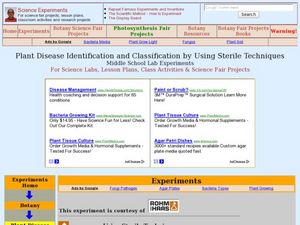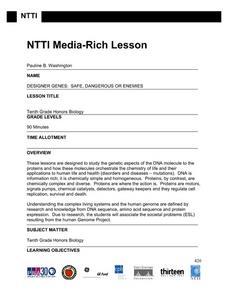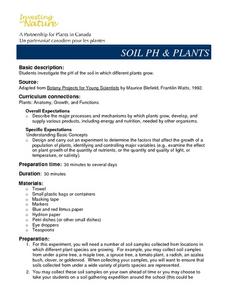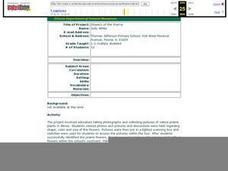Chicago Botanic Garden
Preparing for Project BudBurst
Adopt a plant and get to know its phenophases. The third instructional activity in a six-part series combines plant identification and phenology. Pupils begin by creating their own field guides to learn about the features and...
Curated OER
Plant Identification Pictionary
Students participate in a plant identification game. Using worksheets, they collect plant samples and identify the basic parts of the plant. They note the similarities and differences between the various diagrams. They use heavy books...
Curated OER
Schoolyard Jungle: What's Out There?
Eighth graders create a plant study guide using their outdoor classroom environment. In this ecology instructional activity, 8th graders take photographs of plants they collect from the outdoor classroom and create plant field...
Curated OER
Plant Disease Identification and Classification by Using Sterile Techniques
Seventh graders identify how to use sterile techniques when identifying plant pathogens. In this plant diseases lesson students complete a lab activity in which they see how plant diseases are identified and classified.
Curated OER
Arizona Plant Booklet: An Introduction to Arizona Plants & Cacti
Students explore variety of plants & cacti in their Arizona community by collecting samples and taking photographs. Can be adapted to other areas.
Curated OER
Temperature and the Tomato
You will need a photovoltaic system and monitor at your school in order to obtain all of the data required to thoroughly implement this lesson plan. Your class monitors daily temperature and insolation amounts over a two week span of...
Curated OER
Using Sterile Techniques as a Tool in Studying Plant Diseases
Seventh graders examine the concept of sterile techniques. They realize that plant diseases can be identified and classified in various way. Students identify some of the diseases that attack the garden plants.
Curated OER
Disposable Diaper Comparison and Mystery Powder Identification
Students investigate which diaper is the most absorbent. In this chemistry instructional activity, students calculate how much water is absorbed by diapers. They identify an unknown powder based on physical and chemical properties.
Curated OER
Prairie Find Outdoors
Students take a field trip to a local prairie. Using identification books, they identify various forbs and grasses in the prairie. As a class, they discuss the importance of forbs and grasses to the ecosystem and review the various types...
Curated OER
Soil pH & Plants
Students investigate the pH of the soil in which different plants grow. They design and carry out an experiment to determine the factors that affect the growth of a population of plants, identifying and controlling major variables...
Curated OER
Thin Layer Chromatography (TLC)
Students study flavinoids and how they exist in the plant kingdom. In this pigment lesson students complete a lab activity to see how flavinoids move in substances then record their observations.
Curated OER
Let it Grow!
Students explain the relationship of plants and animals in the environment. They name the basic requirements for plant growth and define the terms photosynthesis, stomata, chlorophyll and xylem.
Curated OER
Flowera of the Prairie
Students with severe disabilities view pictures of flowers in a scanning box and identify them. Outside, they locate flowers on the school's property, label and care for them. Students use flower pictures to aid identification.
Curated OER
Fossil Kit II
Youngsters examine four fossil replicas and chart their time periods, vertebrate or invertebrate, and the names of other organisms living at the same time. A specific fossil kit is available for sale if you do not have the same samples....
Curated OER
Chromatography
Students conduct various experiments on chromatography. In this chemistry instructional activity, students distinguish among the different types of chromatography methods. They explain how the stationary and mobile phase interact with...
Curated OER
Testing the Waters
Eleventh graders examine a local body of water. In this science lesson, 11th graders collect water samples to test. Students analyze the data and make conclusions. Students create tables and graphs of the data.















